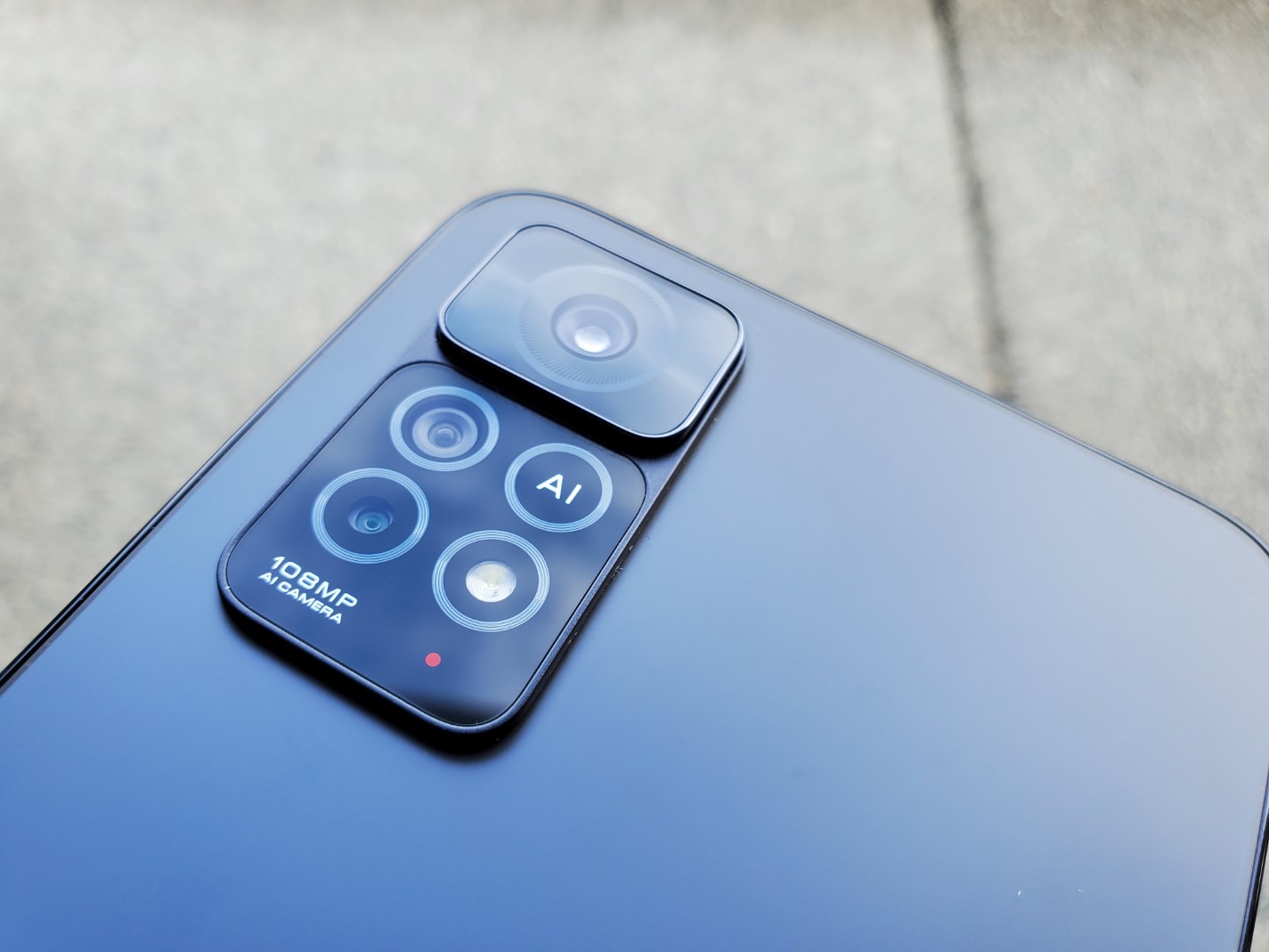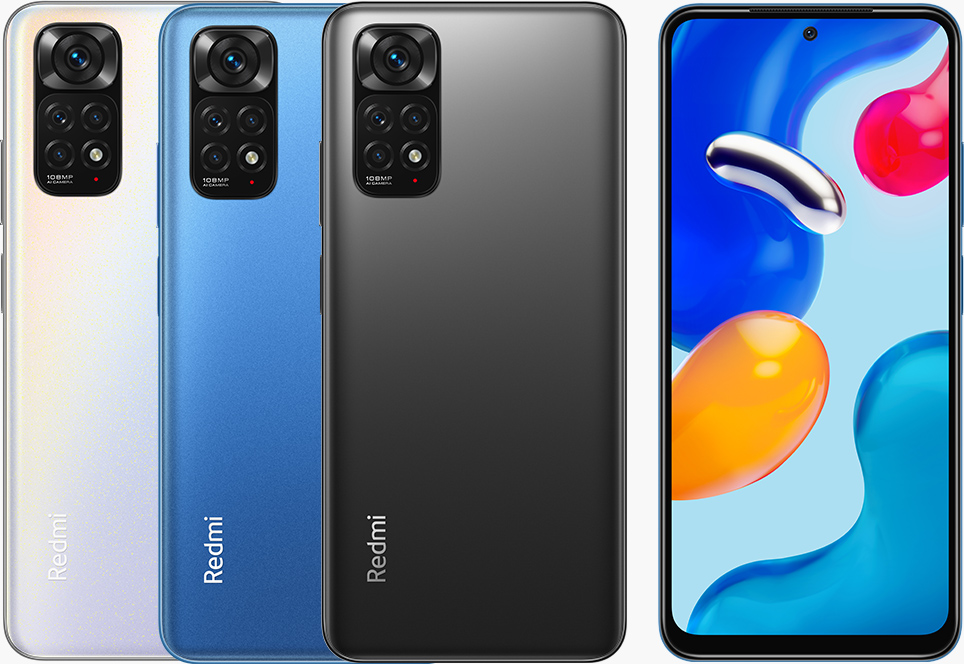These two phones are priced just below $400 but have compelling design elements and solid specifications. For those looking for a more affordable phone, one of these two may be a good fit. There are a ton of similarities between the two phones, with a couple of minor feature differences that may sway you to one over the other. The phones are priced about $85 apart, but the lower cost Note 11S may be the better buy for US customers.
Hardware
I was sent both phones in the Graphite Gray color, and when they are face down on a surface, I have to look for the 5G branding to figure out the difference. The Note 11 Pro 5G is larger and has a flat back panel, while the Note 11S has curves around the edges that transition into the sides of the phone. One other difference on the back is that the Note 11S has four camera openings, while one of the openings on the Note 11 Pro has the words AI over the opening instead. The 108MP main camera is a large module at the top, with the other supporting camera lenses appearing below this camera on the back left side. Both phones have a frosted back appearance that appears professional and provides a solid grip. The back of the Note 11 Pro is glass, and the Note 11S is plastic, but not the cheap glossy material you might see on other plastic phones. The edges of the phones are square with rounded corners. The USB-C port, mic opening, and bottom speaker is on the bottom edge. There is a speaker, mic opening, IR blaster, and 3.5mm audio port on the top of the phones. There is nothing on the left with the volume and power/fingerprint sensor on the right. Both phones have a fingerprint sensor built into the power button, which is my favorite security setup for smartphones, and activating it is reliable and quick. The AMOLED displays are lovely, with good brightness levels, solid resolution, and high refresh rates. Higher refresh rates in budget phones are not that common, and we see 120Hz in the Note 11 Pro and 90Hz in the Note 11S, so both offer a great viewing experience. Minimal bezels are found all around the display, with a very tiny hole punch camera centered at the top of the display. Similar to the Galaxy S22 Ultra, the front camera is under the glass panel but not under the viewable display. Overall, there is nothing particularly remarkable about the hardware, but neither phone feels like a budget phone in the hand. The deeper flat edges, slightly denser feel, and glass back of the Note 11 Pro means this is the one I would pick if I had to make a choice on the feel of the phone in my hand. Also: Best cheap phone 2022: Flagship features for under $450 Each phone has a large capacity 5,000 mAh battery, so you can easily get through a full day of use. The Note 11 Pro 5G supports 67W turbocharging, while the Note 11S supports 33W fast charging. Xiaomi states that the 67W charger can charge up the Note 11 Pro 5G to 50% in 15 minutes and to 100% in 42 minutes. The Samsung 108MP camera is the main shooter on this phone with 9-in-1 binning support. An 8MP ultra-wide camera with a 118-degree field-of-view is also found on both phones. A 2MP macro camera wraps up the triple cameras on the Note 11 Pro, while the Note 11S also adds in a 2MP depth camera for improved portrait shots. The camera performance was solid, especially for budget phones, but there is no telephoto camera, and the cameras are challenged in low light conditions. Both phones support common LTE networks, and I experienced solid cellular reception with my T-Mobile SIM card. The Note 11 Pro 5G supports 5G on many different bands, but with my T-Mobile SIM, only band n41 (old Sprint 2.5 GHz network) is supported, so 5G support is limited in the US. The IR blaster, 3.5mm audio port, and microSD card support are relics of the past on flagship smartphones, so if these features are important to you, then you may want to consider a Redmi Note 11S or 11 Pro 5G.
Specifications
Processor: Qualcomm Snapdragon 695 (Note 11 Pro) or MediaTek Helio G96 (Note 11S)Display (Note 11 Pro): 6.67-inch, 2400 x 1080 pixels resolution, AMOLED with 120Hz refresh rateDisplay (Note 11S): 6.43-inch, 2400 x 1080 pixels resolution, AMOLED with 90Hz refresh rateOperating system: Android 11 with MIUI 13RAM: 8GBStorage: 128GB with microSD cardCameras: 108MP rear f/1.9 wide-angle camera, 8MP f/2.2 ultra-wide camera (118 degrees field-of-view), 2MP macro, and 2MP depth (Note 11S only). 16MP f/2.4 front-facing camera.Connectivity: 802.11 a/b/g/n/ac Wi-Fi, Bluetooth 5.1, GPS/Galileo/GLONASS/Beidou, NFCSensors: Accelerometer, Gyro Sensor, Geomagnetic Sensor, Proximity Sensor, Ambient Light Sensor, IR blasterWater resistance: IP53 splashproof protectionBattery: 5000 mAh non-removable with fast charging.Dimensions (Note 11 Pro): 164.19 x 76.1 x 8.12mm and 202 gramsDimensions (Note 11S): 159.87 x 73.87 x 8.09mm and 179 gramsColors (Note 11 Pro): Polar White, Graphite Gray, Atlantic BlueColors (Note 11 Pro): Pearl White, Graphite Gray, Twilight Blue
The display size and resolution, 2MP depth camera, 5G network support, and glass back panel of the Note 11 Pro are the primary differences between these two affordable phones. The Note 11 Pro has a flatter feel to it than the 11S, but with the limited 5G support, the 11S may be the better option that also includes a cost savings.
Software
One area where it is obvious these are not flagship phones is the software. Both phones launch with MIUI 13 built on Android 11 even though Android 12 has been out for many months. Both were updated to the February Android security update during our review period, so that is encouraging. Hopefully, Android 12 comes to these phones in the next couple of months, but we don’t have high expectations for budget phones getting reliable and long term software support. MIUI 13 offers a mostly stock Android experience with primary differences observed in the notification shade and additional settings. Special features available in MIUI 13 include a sidebar, floating windows, second space, and lite mode. There are extra gesture shortcuts, quick ball, and other settings are also available to help you create a personalized experience with the phone. Also: Best Android phones: Top expert picks Along with the 108MP camera hardware and other cameras, the Redmi Note 10 Pro includes advanced camera software with a plethora of shooting modes. These include 108MP with pixel-binning, video, photo, portrait, clone, long exposure (moving crowd, neon trails, oil painting, light painting, starry sky, star trails), night, panorama, documents, vlog, slow motion, time-lapse, dual video, short video, and pro/manual. With solid camera hardware and this software, your ability to get creative and spend a lot of time shooting with this phone is readily available. The 5,020 mAh battery helps ensure you can go all day shooting too.
Daily usage experiences
I’m blessed to be able to test out and write about a plethora of mobile phones here on ZDNet, so I tend to purchase the high-end flagship phones for my personal use. However, if I weren’t testing out so many phones, I would seriously consider one of these phones priced under $400 since they provide a solid piece of hardware, responsive performance, lovely side fingerprint sensor in the power button, access to all the apps I need, an enjoyable media experience, legacy features (IR blaster, microSD card, and 3.5mm audio port), and battery life to last all day. The Redmi Note 10 Pro was tested last year, and a year later, the hardware hasn’t changed much in the 11 Pro. 5G is an obvious addition, but in the US, that has a limited impact on cellular connectivity. Unfortunately, the Note 11 Pro is still currently being powered by Android 11, the same as the Note 10 Pro in early 2021, so Xiaomi needs to step up the firmware game. The Note 11S offers quite a bit for its $300 price, and as long as you aren’t running 20 apps at once or playing high-powered graphical games, then you should be just fine with the processor and performance of the phone. It has great looks, solid build quality and seems to be a much more capable phone than we used to buy at just $300. Since we spend so much time interacting with the display on our phones, the high refresh rate in both of these phones sets them apart from other phones in this price range. The AMOLED display, decent speakers, and headphone port make these solid phones for media. As long as you are not looking to capture professional photos on your phone, then the Redmi Note 11 Pro or 11S are some of the best affordable phones we have tested in 2022.

